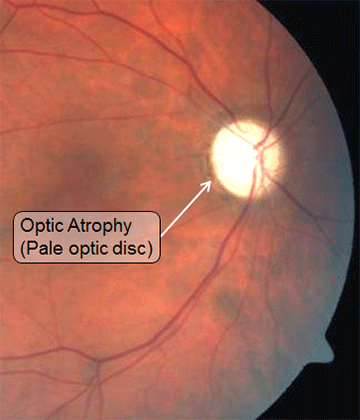-
Learning Units
- Unit 1: Sudden Loss of Vision
- Unit 2: Visual field defects, double vision & optic disc swelling
- Unit 3: Pupil abnormalities, Facial nerve palsy & Ptosis
- Unit 4: Refractive Error
- Unit 5: Children & Squint
- Unit 6: Differential diagnosis of blurred vision
- Unit 7: Gradual Loss of Vision
- Unit 8: Eye Trauma
- Unit 9: Red Eye
- Unit 10: Systemic Disease
- Useful Links
- KEATS
- KCL website
- Contact Us
7: Traumatic Optic Neuropathy
Symptoms
- Rapid loss of vision
Signs
- Visual acuity can be reduced from 6/6 to no perception of light
- Relative afferent pupil defect
- Visual field defect
- Colour vision defect
- Optic nerve may initially appear swollen and subsequently develop atrophy

Image credit: RetinaGallery.com
© Faculty of Life Sciences & Medicine, Faculty Education Services, Digital Education Team. King's College London.
This module was prepared by C. Petrarca and T. Jackson and they retain the intellectual property rights in relation to its contents. The contents of this module must not be reproduced, or used outside King's, without their permission.
Relative afferent pupillary defect
A relative afferent pupillary defect (RAPD) is seen on examination by shining light in one eye, then the other.
If the left eye has an RAPD it will show little constriction of the pupil when a light is shone into that eye, but when the light is shone into the right eye, the left constricts.
When swinging back to the left eye it paradoxically dilates, as it is not as responsive to stimulation (as the optic nerve is damaged).
(See the pupil section for details)
